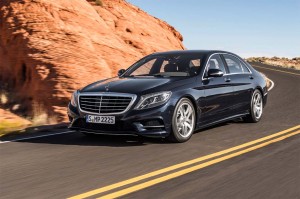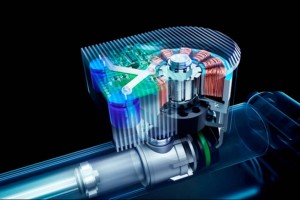With its deeply rutted roads, Michigan just might turn into the energy capital of the world if ZF has its way.
The German automotive parts maker has developed what it claims to be the “world’s first fully active, regenerative suspension.” While a number of other suppliers have developed active suspension concepts over the years, ZF Friedrichshafen AG has teamed up with Levant Power Corp. to produce a system that actually works like the regenerative braking system in a hybrid vehicle, recapturing energy whenever the suspension gets jostled.
While the concept likely won’t be used to power your car, it does address one of the biggest problems with earlier active suspension concepts, such as one Massachusetts-based Bose demonstrated a few years back. Past designs have required vast amounts of energy to operate, and that meant bigger alternators and heavier batteries – cutting into fuel economy, among other things.

The 2014 S-Class features a "Magic Body Control" system using stereoscopic cameras to respond to changing road conditions.
The plus side of an active suspension is that it can do a lot more to smooth out the bumps and ruts a car contacts every day. On paper, at least, replacing purely mechanical components with electric or electro-hydraulic systems like ZF and Levant use can minimize, even eliminate the jostles passengers feel. The Bose prototype system even allowed a Lexus test vehicle to jump over an obstacle.
“Automakers have long sought a suspension that allows sport cars handling while maintaining the comfort of a premium luxury sedan,” notes a ZF news release. “The difficulty in achieving this outcome rests in balancing comfort and handling; comfort requires a soft suspension to absorb bumps, while handling requires stiffness for control. Previous attempts to achieve high-bandwidth active suspension have fallen short due to cost, complexity and power consumption.”
The ZF/Levant system has a new, electronic system to control each shock, with an electric motor and e4lectrohydraulic pump that controls the rate of damping – which determines how soft or firm the shock is when it hits a bump.
The secret sauce, as it were, is that the additional hardware can also recapture power from each bounce, as well as when the car accelerates or slows, and even when it corners, transforming kinetic energy into a jolt of electricity fed into a battery or the vehicle’s main power supply.
The system would not only smooth out your typical drive but even permit a manufacturer to eliminate the traditional jack. Get a flat and simply press a button. The suspension can raise any individual wheel electrically.
“Ride and handling are at the core of the driving experience. With GenShock-technology, ZF and Levant will reinvent that experience,” suggests Shakeel Avadhany, Founder & CEO of Massachusetts-based Levant Power.
The two partners aren’t talking price – though it is expected to be costly enough that such a system would first appear on a luxury car.
(High-tech suspensions can smooth out the bumps. Click Here for more.)
High-tech suspensions are becoming more and more common, many using what is known as semi-active technology to soften bumps while firming up under aggressive driving. The new 2014 Chevrolet Corvette, for example, has the latest-generation magnetic ride control system developed by supplier Delphi. It replaces conventional shock oil with a magnetorheological fluid that becomes thicker or thinner by applying various levels of magnetic force.
The new 2014 Mercedes-Benz, meanwhile, features a stereoscopic camera-controlled system, dubbed Magic Body Control. It scans the road ahead and rapidly alters suspension damping to compensate for road conditions.
(First drive: 2014 Mercedes-Benz S-Class. Click Here for the review.)
Expect to see even more “smart” suspension systems to follow in the coming years as microprocessors, along with vision and other sensing systems, get faster, more accurate and less expensive.


I knew this would eventually happen and it’s a real good idea as shocks generate a lot of heat energy due to their constant motion. Now with reverse power generation they can actually increase mpg on both electric and hybrid vehicles. They could eventually produce enough energy to increase mpg on gas/Diesel engines also.
Yea something more to break down and create exorbitant service diagnostic and replacement costs in the field energy tards are getting ridiculous.
next thing they will put a windmill on the roof!
Reminds me of the little headlight generators that ran off of bicycle tires that usually did not work.